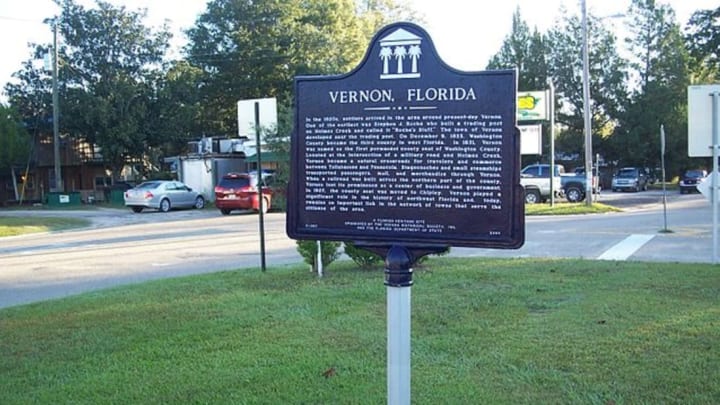After a few frustrating days in Vernon, Florida, in the 1980s, renowned filmmaker Errol Morris learned a hard truth: People who blow their limbs off to score insurance payouts don’t like being the subject of documentaries.
Morris did eventually get a film out of his time in the town—the 1981 documentary Vernon, Florida—but not the one he originally set out to make: the one about amputees and insurance fraud, the one he intended to call Nub City. What became a quirky flick about a town’s eccentrics was initially meant to be an investigation of the so-called Nub Club. But when club members declined to comment (except with death threats and assault), Morris pointed his camera elsewhere.
Morris described the creative dead-end and his self-preservation instincts in an interview with The 7th Avenue Project:
I knocked on the door of a double-amputee, who was missing an arm and a leg on opposite sides of the body—the preferred technique, so that you could use a crutch. His buff son-in-law, a Marine, beat me up. I decided whatever I was doing was really, really stupid and dangerous.
In the late 1950s and early 1960s, it wouldn’t have been inaccurate to blame the brisk pace of rising insurance premiums on the Nub Club. By the end of the ’50s, the Florida Panhandle was responsible for two-thirds of all loss-of-limb accident claims in the United States. And Vernon, Florida, was the epicenter.
It’s not clear whether the first member of the Nub Club, the unintentional founder, entered by choice or by accident. Maybe there was an accident at the factory. Or maybe it was a calculated choice—brought on by the sputtering economics of small town America.
What is clear is that, at some point in the early ’50s, the idea of trading one’s limb for a few thousand dollars became seductive enough an option to a significant percentage of Vernon’s population. By the mid '60s, at least 50 of Vernon's 700 residents had joined the Nub Club by way of farming accidents, garage mishaps, hunting incidents, and so on. Although a few Vernon residents had the boldness to saw and hack off their limbs, most preferred the brevity of the shotgun blast.
Insurance agents in the region became filled up with stories as outlandish and darkly humorous as they were sad. One agent recalled a list of clients from the Panhandle: a fellow who maimed his foot while trying to protect his chickens, a man aiming for a hawk who took off his own hand, a trigger-happy farmer who mistook his foot for a squirrel. Several accidents involved both firearms and motor vehicles. One man lost two limbs in an incident involving his tractor and a loaded rifle.
Many of these Nub Club members took out multiple insurance policies, sometimes just days or hours before the dismemberment. Mounting insurance premiums failed to slow the trend. The scheme made some men millionaires.
The story of one agent, relayed by St. Petersburg Times’ writer Thomas Lake, really captures the absurdity of the local episode:
"There was another man who took out insurance with 28 or 38 companies," said Murray Armstrong, an insurance official for Liberty National. "He was a farmer and ordinarily drove around the farm in his stick shift pickup. This day - the day of the accident - he drove his wife's automatic transmission car and he lost his left foot. If he'd been driving his pickup, he'd have had to use that foot for the clutch. He also had a tourniquet in his pocket. We asked why he had it and he said, 'Snakes. In case of snake bite.' He'd taken out so much insurance he was paying premiums that cost more than his income. He wasn't poor, either. Middle class. He collected more than $1 million from all the companies. It was hard to make a jury believe a man would shoot off his foot."
Of course, these payouts rarely came with a condolence card. The insurance companies quickly recognized the trend, and before long were wise to the ruse. Insurers took many of the Nub Club members to court. The problem was convincing a jury that a man with any sense at all would have the gumption to aim a rifle at one of his appendages and pull the trigger. Lawsuits were of no use. Not a single amputee in Vernon or the surrounding area was convicted of fraud.
Eventually, the insurance companies got together and sent an investigator by the name of John J. Healy to Vernon to snoop around. He quickly confirmed what the local agents and the suits back at headquarters already knew.
"To sit in your car on a sweltering summer evening on the main street of Nub City," he wrote in a report, "watching anywhere from eight to a dozen cripples walking along the street, gives the place a ghoulish, eerie atmosphere."
Healy’s investigation was recalled by Ken Dornstein’s 1996 book, Accidentally, on Purpose: Making of a Personal Injury Underworld in America. According to Dornstein, Healy once unsympathetically remarked that the second most popular pastime in Vernon was gathering in the town square to watch the local stray mutts mate. The top activity, he said, was self-mutilation for cash.
In the early ’60s, the insurers put an end to the practice before the town of Vernon depleted itself of limbs—but not before it earned its now inescapable nickname. Premiums became astronomically high in the region, and most insurers simply refused to do business with the Panhandle.
It wasn’t until a New Yorker blurb recalled the small town’s pathetic past two decades later that Morris decided to make a trip to the Deep South. Though he failed to put that past on film, his trip helped resurrect a sad but compelling chapter of American economic history.
